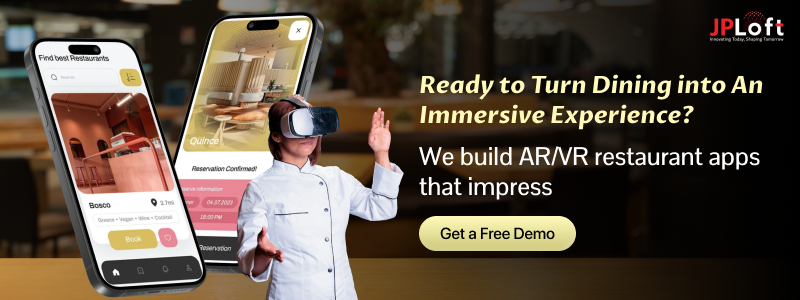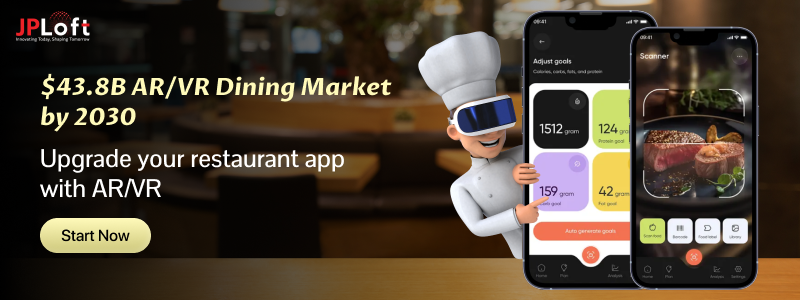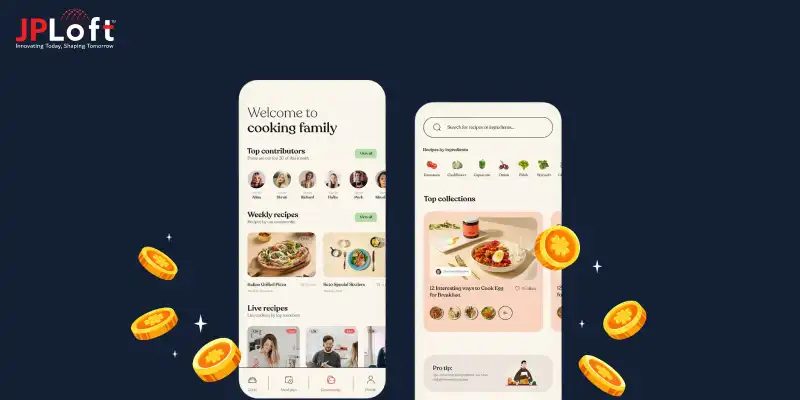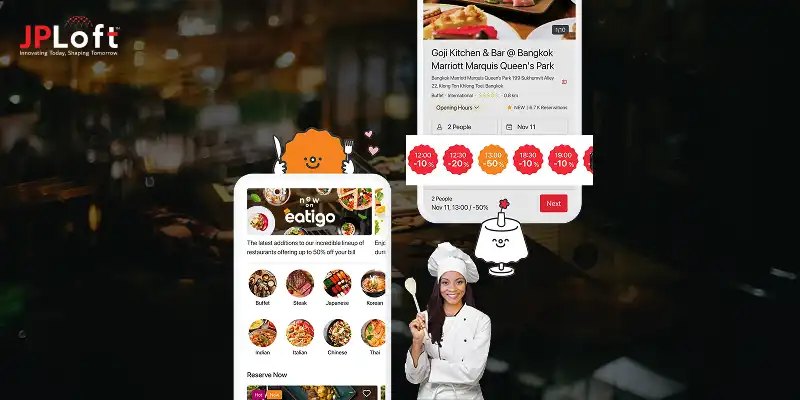The dining experience is no longer limited to menus and table service. With the rise of immersive technology, restaurants are reimagining how customers interact with their brands.
From virtual menus to augmented table-side ordering, the question today is, “How AR/VR is transforming restaurant apps?”
AR/VR is transforming restaurant apps by offering interactive 3D menus, virtual try-before-you-order experiences, and immersive storytelling that make dining more engaging, personalized, and futuristic.
In 2025, diners expect not just convenience but also digital journeys that feel unique and memorable. This shift highlights how AR/VR is shaping restaurant apps by offering customer satisfaction and loyalty.
Let’s get to know all about how AR/VR helps restaurant apps and their role and impact.
Key Takeaways
The role of AR/VR in restaurant apps is revolutionizing dining experiences by offering interactive menus, virtual tours, and immersive storytelling that engage and delight customers.
Integrating AI with AR/VR enhances personalization, suggesting dishes, customizing orders, and delivering a highly tailored digital dining journey.
Core features like 3D menu visualization, VR-powered restaurant tours, gamification, and immersive ordering are essential for modern restaurant apps.
Restaurants adopting AR/VR can boost customer engagement, loyalty, and revenue while differentiating themselves in a competitive market.
Understanding how to build an AR/VR restaurant app helps businesses plan and implement features that maximize engagement and long-term success.
Partnering with a trusted development partner like JPLoft ensures your restaurant app leverages the latest AR/VR innovations while maintaining high performance, scalability, and seamless user experiences.
What is AR/VR in the Restaurant Apps?
Augmented Reality (AR) overlays digital elements onto the real world, while Virtual Reality (VR) immerses users in a simulated environment.
In restaurant apps, these technologies create interactive dining experiences, and customers can view 3D dishes, take virtual tours of interiors, or even place immersive food orders.
The role of AR/VR in restaurant apps goes beyond novelty; it simplifies decision-making and enhances engagement, helping restaurants stand out in a competitive market.
Many businesses exploring how to develop a restaurant app are now integrating AR/VR as a standard feature, recognizing its ability to transform the way users connect with menus and services.
A] How AR/VR Enhances the Dining Experience?
The functions of AR/VR in restaurant apps can be seen in interactive menus where users rotate, zoom, and visualize dishes before ordering.
Similarly, VR headsets allow customers to explore themed dining experiences, making eating out more memorable.
This evolution also reshapes user expectations; people now look for apps that offer engagement alongside convenience.
Restaurants aiming to compete with popular platforms are realizing that immersive features, showcased through innovative restaurant app ideas, add immense value, both for customer satisfaction and brand differentiation.
B] Why AR/VR Matters for Restaurants Today?
With technology adoption accelerating in 2025, AR/VR in the restaurant industry is no longer a futuristic concept but a present-day strategy.
These tools strengthen brand identity, build customer loyalty, and create new revenue opportunities.
Alongside AR/VR, AI integration is becoming essential. Understanding the role of AI agents in restaurant apps helps restaurants deliver personalized experiences, such as suggesting dishes, offering dynamic recommendations, and guiding users through menus in real time.
However, early adopters must also be mindful of potential obstacles such as higher costs or complex integrations.
Still, the trend is clear: restaurants that embrace immersive technologies are better positioned to attract tech-savvy diners and redefine the dining experience.
How AR/VR is Transforming Restaurant Apps?
Traditional menus often limit customers’ imagination, leaving them guessing about portion sizes, ingredients, or presentation.
With AR integration, menus evolve into interactive experiences where diners can rotate, zoom, and preview dishes in 3D.
This shift clearly answers the question, “How AR/VR is transforming restaurant apps?” by eliminating uncertainty and encouraging more confident ordering.
As restaurants embrace innovative digital solutions, AR has become one of the most sought-after enhancements for both casual dining and fine-dining establishments.
A] VR-Powered Virtual Dining & Ambience Tours
Beyond menus, VR allows restaurants to create immersive journeys where users can preview the interior ambience before booking a table.
Imagine exploring a rooftop restaurant’s view or a themed dining setup all from your phone or VR headset.
This integration shows the growing impact of AR/VR technology in restaurant apps, where immersive storytelling helps restaurants differentiate themselves.
Incorporating such interactive and visually engaging experiences has proven effective in attracting modern, experience-driven customers.
B] Boosting Customer Engagement and Loyalty
AR/VR also introduces gamified experiences such as loyalty rewards, virtual chef interactions, and personalized recommendations.
These innovations keep users returning, making engagement more fun and dynamic. With AI in restaurant apps now combined with AR/VR, restaurants can personalize menus based on dietary preferences, past orders, and visual appeal.
Experiences like virtual cooking tutorials or themed AR filters for social sharing push loyalty beyond discounts, fostering deeper connections between customers and the brand.
C] The Broader Impact on Restaurant Businesses
For restaurants, the role of AR/VR in the restaurant apps transformation is not just about entertainment; it drives measurable business outcomes.
Immersive menus reduce order hesitations, VR tours increase reservations, and gamification boosts repeat visits.
This is how restaurant apps make money in new and engaging ways. By integrating AR/VR, businesses elevate brand value, create new revenue streams, and redefine customer experience standards in 2025 and beyond.
Core Features of AR/VR in Restaurant Apps
AR and VR are no longer futuristic buzzwords; they are now practical tools transforming how diners interact with restaurant apps. These technologies bring transparency, personalization, and entertainment to the dining journey, helping brands stand out in a competitive market.
Below are the top restaurant app features that are reshaping digital dining experiences.
1. AR-Powered Interactive Menus
Static menus are fading as AR introduces interactive 3D dish previews. Diners can visualize portion sizes, plating styles, and even ingredient details before placing an order.
These innovations reflect the growing functions of AR/VR in restaurant apps, making dining more transparent and engaging.
For entrepreneurs exploring how to start an online restaurant business, AR menus can be a strong differentiator that sets their app apart.
2. Virtual Restaurant Tours with VR
VR technology allows customers to take a virtual tour of a restaurant before making reservations.
From exploring seating layouts to experiencing themed interiors, VR creates a sense of familiarity and comfort.
Adding such features is often considered a best practice in a restaurant app design, as they not only help apps stand out but also boost customer confidence.
3. Immersive Ordering and Table Customization
Imagine being able to place your phone over a table and customize seating arrangements or preview dishes in real-world spaces.
This is one of the innovative uses of AR/VR technology in restaurant apps, creating personalized ordering experiences.
However, ignoring usability testing in such features often explains why restaurant apps fail, as even cutting-edge tech must remain simple and user-friendly.
4. Gamification and Loyalty Programs
AR filters, collectible digital badges, and VR-based mini-games are increasingly integrated into apps to boost customer loyalty.
Such features go beyond discounts and foster engagement that feels fun and rewarding.
Developers focusing on the steps to create an AR/VR restaurant app often add gamification to improve user retention and encourage repeat orders.
5. Personalized Dining Experiences
By combining AI with AR/VR, restaurants can personalize menus based on dietary preferences, mood, or past orders.
Having such features might spike your overall cost to develop a restaurant app, but this personalization enhances upselling opportunities while making users feel valued.
Restaurants can study successful platforms to understand how AR/VR contributes to advanced personalization, designing experiences that truly cater to individual preferences.
6. AR-Based Nutritional Information
AR can provide diners with real-time nutritional details by scanning dishes or menu items.
Customers can view calorie counts, allergen info, and ingredient sourcing instantly through AR overlays, making health-conscious decisions easier.
This feature not only improves transparency but also builds trust with diners who prioritize nutrition and dietary needs.
7. VR Cooking Classes and Live Demonstrations
VR allows restaurants to offer virtual cooking classes or live chef demonstrations directly within their app.
Users can learn recipes, cooking techniques, or watch behind-the-scenes kitchen processes, creating a deeper engagement with the brand.
Such immersive experiences elevate brand loyalty and turn a dining app into an interactive culinary platform.
8. AR-Enhanced Tabletop Entertainment
AR can transform the dining table into an interactive experience.
Customers can play AR games, visualize food in 3D, or interact with themed animations while waiting for their order.
This feature enhances customer enjoyment, encourages social sharing, and differentiates the app in a competitive market.
How to Integrate AR/VR in Restaurant Apps?
This is where the dining experience goes truly digital, making your app more than just a menu; it becomes a destination.
If you want to develop a restaurant finder app that stands out in 2025, using AR/VR to let customers "see before they eat" is a massive game-changer.
In this section, we'll dive into the specific ways you can leverage Augmented and Virtual Reality to elevate your restaurant application:
Step 1: Analyzing Business Needs and User Expectations
This is one of the first steps to create an AR/VR restaurant app. You understand the restaurant’s goals and the expectations of its customers.
Are you aiming to increase reservations, reduce order errors, or create a memorable dining experience?
Identifying these objectives ensures the role of AR/VR in restaurant apps is meaningful rather than superficial.
Restaurants should gather user feedback through surveys, study competitors, and analyze app usage patterns.
This research helps determine which AR/VR features, such as interactive menus, virtual tours, or table customization, will provide the most value.
Additionally, integrating features like AI voice ordering in restaurant apps can complement AR/VR, creating a seamless and highly personalized user experience.
Step 2: Choosing the Right AR/VR Tools and Platforms
Once the objectives are clear, the next step is selecting the technology stack. Developers can choose from a variety of AR and VR SDKs (Software Development Kits) and frameworks, depending on whether the app will be mobile-first, web-based, or cross-platform.
Popular tools include ARKit for iOS, ARCore for Android, and Unity or Unreal Engine for VR experiences.
While deciding, consider scalability, device compatibility, and integration with existing restaurant systems.
For restaurants planning how to build a restaurant booking app, it’s crucial that AR/VR components do not slow down app performance.
Leveraging cloud services for rendering 3D assets or hosting VR content can improve responsiveness and reduce app crashes.
Step 3: Designing AR/VR Features for Seamless Experience
Design plays a pivotal role in the success of AR/VR features. Poorly designed experiences can frustrate users, whereas intuitive interfaces boost engagement. Focus on these elements:
-
AR menus: Allow customers to view dishes in 3D, rotate them, and examine portion sizes.
-
VR tours: Let users explore seating arrangements, ambience, and event spaces virtually.
-
Interactive ordering: Enable customers to customize meals or table settings using AR overlays.
Developers should ensure that all AR/VR features are stable and consistent across devices, providing a smooth and visually appealing experience for every user.
UX designers can also collaborate with restaurant owners to incorporate branding elements, making the immersive experience feel authentic and aligned with the restaurant’s identity.
Step 4: Testing and Iterating for Performance
Testing is essential before launching AR/VR features to the public. Unlike standard app features, immersive experiences require validation across multiple devices and operating systems. Check for:
-
Smooth rendering of 3D models
-
Accurate AR tracking in different lighting conditions
-
Minimal latency in VR interactions
-
Compatibility with existing ordering and payment systems
This stage often reveals potential pitfalls that could hinder adoption. Conducting thorough restaurant app testing is recommended to systematically evaluate performance, user engagement, and technical stability.
Iteration is key; feedback from beta users helps refine AR/VR features, ensuring they meet user expectations.
Step 5: Deployment and Long-Term Support
After rigorous testing, the AR/VR features can be deployed alongside the main restaurant app.
However, integration doesn’t end at launch. Regular updates, bug fixes, and feature enhancements are necessary for long-term success.
Restaurants should establish a robust restaurant app maintenance process to monitor performance, track user interactions, and plan for future improvements.
Moreover, combining AR/VR with other advanced technologies like AI can further elevate experiences.
Besides, continuous support ensures that the app remains relevant, competitive, and aligned with evolving customer expectations.
Additional Tips for Effective AR/VR Integration
-
Keep it Simple: Immersive experiences should enhance, not complicate, the ordering process.
-
Prioritize Performance: High-quality AR/VR experiences should not cause app lag or crashes.
-
Educate Users: Provide in-app tutorials or onboarding tips to help customers navigate AR/VR features.
-
Measure Engagement: Track which AR/VR features increase orders, reservations, or app retention.
-
Plan Monetization: Some restaurants monetize VR experiences through exclusive access, premium menus, or event bookings.
Integrating AR/VR into restaurant apps is a strategic investment. Following this process to develop an AR/VR restaurant app ensures that technology adoption is purposeful, enhances the user experience, and drives measurable business outcomes.
Real-World Examples of AR/VR in Restaurant Apps
AR and VR are no longer futuristic buzzwords; they are actively shaping the way restaurants interact with customers.
Several leading brands have already implemented immersive dining solutions, highlighting why these innovations are featured among the best restaurant apps globally.
These examples showcase the real-world impact of AR/VR technologies in enhancing engagement, personalizing experiences, and improving customer satisfaction.
1. AR-Powered Menus at Pizza Hut & KFC
Pizza Hut experimented with AR menus that let customers scan boxes and explore interactive games and deals, while KFC tested AR apps that gamify ordering.
These apps show how brands can create a mobile app that boosts engagement and reduces menu-related doubts by offering 3D visualization of food items.
2. Domino’s AR Pizza Builder
Domino’s launched an AR-based pizza builder where customers can design and preview their pizzas in real time before ordering.
This innovation demonstrates how restaurants can integrate AR with personalization to give users control over their dining experience while improving order accuracy.
3. Starbucks AR Store Tours in Shanghai
Starbucks introduced AR-powered tours in its Shanghai Reserve Roastery, where customers could point their phones at objects to access immersive stories about coffee-making.
By combining AR storytelling with AI-driven suggestions, Starbucks set an example of how immersive technology can elevate customer engagement and create memorable brand experiences.
4. TheFork’s AR Reservation Experience
TheFork is exploring AR features that allow users to preview restaurant layouts, table settings, and seating options virtually.
This clearly showcases that how creating a restaurant booking app like TheFork can help leverage immersive technology to improve user decision-making.
5. OpenTable and the Use of AR/VR in the Future
OpenTable is experimenting with AR/VR to provide immersive previews of restaurant interiors and dining experiences.
This demonstrates why understanding the cost to build a restaurant reservation app like OpenTable is critical when planning such advanced features.
Measurable Business Impact
These examples show that AR/VR adoption leads to real results: higher engagement, larger order sizes, stronger loyalty, and positive customer buzz.
Restaurants that integrate immersive technologies also gain measurable ROI, proving that AR and VR are not just trends but strategic tools for growth in 2025.
Challenges in Building an AR/VR Restaurant App
While AR/VR offers exciting opportunities, developing such features comes with unique restaurant app development challenges.
Restaurants must navigate high costs, technical complexities, and user adoption hurdles to deliver seamless immersive experiences.
Let’s explore the main challenges of integrating AR/VR into restaurant apps:
► High Development Costs and Resource Requirements
One of the main obstacles in AR/VR adoption is the growing mobile app development cost with it.
Developing immersive AR/VR features requires specialized software, skilled developers, and sometimes additional hardware like VR headsets.
Restaurants must plan budgets carefully, balancing the investment with expected returns. Collaborating with experienced development teams can help ensure high-quality output while optimizing timelines.
Additionally, leveraging flexible development resources for specialized features provides cost efficiency without compromising app performance.
► Technical Complexity and Compatibility Issues
Integrating AR/VR into restaurant apps involves navigating complex technical requirements. Developers must ensure the app runs smoothly across multiple devices and operating systems.
Careful planning of the app’s architecture is crucial for handling AR/VR content without causing lag or crashes.
Additionally, AR/VR SDKs and frameworks can present learning curves, making it important to hire experienced teams.
► User Adoption and Usability Concerns
Even with cutting-edge AR/VR features, success depends on users adopting them seamlessly.
If the experience is confusing or slow, diners may abandon the app. Clear onboarding, intuitive interactions, and performance optimization are essential.
Regular updates and performance checks help ensure the app remains smooth and user-friendly, keeping diners engaged and satisfied.
► Maintenance and Update Challenges
AR/VR content isn’t static. Restaurants need to update virtual menus, 3D models, and immersive tours regularly.
Maintaining high performance while rolling out updates requires dedicated effort.
Partnering with reliable development teams that offer mobile app maintenance services ensures these updates are handled efficiently, keeping the app running smoothly without disrupting the customer experience.
► Integration with Existing Systems
AR/VR features must integrate smoothly with POS systems, ordering workflows, and backend databases. Poor integration can cause errors in order processing or reservations.
Careful planning and collaboration with development experts mitigate these risks, ensuring that immersive experiences enhance rather than complicate the app.
What is the Future of AR/VR in Restaurant Apps?
The future of restaurant apps is set to be immersive, personalized, and highly interactive.
AR/VR technologies are emerging as new restaurant app trends that promise to redefine how diners discover, order, and experience meals, creating new opportunities for engagement, loyalty, and revenue.
The future of AR/VR in restaurant apps lies in hyper-personalization, driven by deep integration with Artificial Intelligence.
AR menus will move beyond simple 3D models to offer real-time, dynamic information like allergen alerts and nutritional breakdowns overlaid on the actual dish.
VR will be used heavily in staff training, simulating high-pressure kitchen environments to improve efficiency and reduce human error, rather than just customer experiences.
We will see the emergence of 'phygital' dining, where AR glasses allow customers to see virtual celebrity chefs preparing their meal right on their table.
Implementing such advanced, data-driven features typically requires expert AI app development services, ensuring scalable and truly immersive digital experiences
Partner with JPLoft and Build AR/VR in Restaurant Apps
AR/VR is no longer just a futuristic concept; it’s becoming a must-have feature for restaurants looking to deliver immersive, engaging dining experiences.
To bring these innovations to life, you need more than just technology; you need a trusted partner. JPLoft is a leading restaurant app development company with proven expertise in building AR/VR-powered apps that blend creativity, performance, and scalability.
Our team ensures your app not only looks impressive but also drives customer engagement and business growth.
Whether it’s interactive menus, VR tours, or AI-powered personalization, we help you transform your ideas into reality. Partner with JPLoft today and future-proof your restaurant app journey.
Conclusion
The role of AR/VR in restaurant apps is reshaping the way customers interact with dining services, offering immersive experiences that go far beyond traditional app features.
From interactive menus to virtual tours, the impact of AR/VR technology in restaurant apps is driving both customer satisfaction and business growth.
As innovations continue, the use of AR/VR technology in restaurant apps will only expand, helping restaurants deliver unique and memorable journeys.
Ultimately, AR/VR in the restaurant industry is not just a trend; it’s the future. Restaurants that embrace this shift today will be best positioned to lead tomorrow’s competitive digital dining landscape.
FAQs
The role of AR/VR in restaurant apps is to enhance customer engagement through immersive and interactive experiences. AR can allow diners to view 3D dishes before ordering, while VR can provide virtual tours of the restaurant or themed dining experiences. Together, they improve decision-making, build customer trust, and create memorable dining journeys that go beyond traditional app features.
When we look at how AR/VR is transforming restaurant apps, the shift is clear. These technologies are turning apps into powerful engagement tools by offering interactive menus, immersive loyalty programs, and even VR dining events. They enable restaurants to stand out in a competitive market, increase customer retention, and generate new revenue opportunities, all while making dining more convenient and enjoyable.
The key functions of AR/VR in restaurant apps include 3D menu visualization, virtual restaurant tours, immersive ordering experiences, gamification, and AI-driven personalization. These functions improve usability, reduce order errors, and create deeper connections between diners and restaurants. By adopting these features, restaurants can build stronger customer loyalty while showcasing their creativity and innovation.
While the use of AR/VR technology in restaurant apps brings immense value, it also comes with challenges. High development costs, technical complexities, device compatibility issues, and the need for regular updates can be hurdles. Additionally, ensuring users adopt these features without confusion requires strong UX design. Partnering with experienced developers helps overcome these challenges effectively.
The future of AR and VR in the restaurant industry is promising, with trends pointing toward fully immersive menus, AI-powered personalization, and virtual dining experiences. As hardware becomes more affordable and software more sophisticated, adoption will grow rapidly. Restaurants that invest in AR/VR early will be better positioned to meet evolving customer expectations and lead in digital innovation.
The process to develop an AR/VR restaurant app involves several key steps: analyzing business goals, selecting the right AR/VR tech stack, designing user-friendly interfaces, integrating immersive features, testing for performance, and maintaining updates post-launch. By following this structured approach, restaurants can ensure their apps deliver engaging and seamless experiences to users.













Share this blog